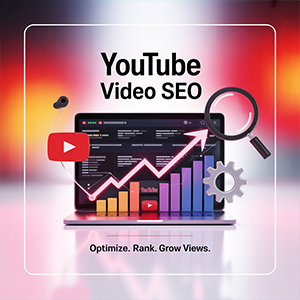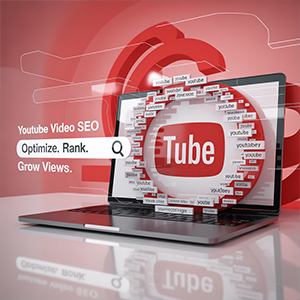


YouTube Video SEO: The Complete Guide to Ranking Higher on YouTube
YouTube Video SEO (Search Engine Optimization) is the process of optimizing video content to rank higher in YouTube’s search results and suggested videos. With over 2 billion logged-in users monthly, YouTube offers massive potential for visibility, making SEO essential for growing a channel organically.
Effective YouTube SEO begins with thorough keyword research. Creators must identify relevant keywords that their audience is actively searching for. These keywords should be strategically placed in the video title, description, and tags to help YouTube’s algorithm understand the content. A compelling, keyword-rich title improves click-through rates, while a detailed description adds context for both viewers and search engines.
Thumbnails also play a vital role, as eye-catching visuals attract more clicks. In addition, using captions and transcripts improves accessibility and keyword recognition. User engagement signals—like watch time, likes, comments, and shares—further influence a video’s ranking.
Creating high-quality, engaging content ensures that viewers stay longer, boosting average view duration, a critical ranking factor. Consistent uploads, playlists, and well-structured channel metadata help improve overall channel authority.
Ultimately, YouTube Video SEO is about combining strategic optimization techniques with valuable content to grow visibility, increase traffic, and build a loyal audience. It’s a powerful tool for creators and marketers alike.
1. Introduction to YouTube SEO
YouTube is not just the world’s largest video platform — it’s the second-largest search engine after Google. With billions of monthly users and millions of content creators, the competition is intense. YouTube Video SEO (Search Engine Optimization) is the strategy that helps your videos rank higher in YouTube’s search results, improve visibility, and drive more organic traffic.
SEO for YouTube involves optimizing your videos, channel, and metadata (title, description, tags, etc.) to match the platform’s algorithm, which favors relevancy, engagement, and viewer satisfaction. The better your SEO, the more likely your content is to be discovered and viewed by your target audience.
2. Why YouTube SEO Matters
YouTube SEO is essential for several reasons:
- Increased Visibility: Optimized videos are more likely to appear in search results and suggested video feeds.
- Higher Engagement: Relevant and SEO-optimized content attracts viewers, encouraging longer watch times and higher interaction.
- Monetization Potential: Better SEO can lead to more views, more subscribers, and more opportunities for monetization.
- Brand Growth: Ranking higher can position you or your brand as an authority in your niche.
With over 500 hours of video uploaded every minute, SEO is what separates discoverable content from the noise.
3. Understanding YouTube’s Algorithm
YouTube’s algorithm is designed to serve viewers the most relevant and engaging content. It uses multiple signals, including:
- Watch Time: How long viewers watch your videos.
- Engagement: Likes, comments, shares, and subscriptions.
- Click-Through Rate (CTR): How often people click your video after seeing the thumbnail and title.
- Relevancy: Based on keywords in the title, tags, description, and captions.
- User History: YouTube also personalizes search results based on the viewer’s behavior.
Mastering the algorithm requires both technical optimization and content that keeps users watching.
4. Keyword Research for YouTube
Like Google SEO, keyword research is the foundation of YouTube SEO. Here’s how to do it:
4.1. Tools for Keyword Research
- YouTube’s Search Suggest: Type a keyword into YouTube’s search bar and note the suggestions.
- TubeBuddy: Chrome extension that provides keyword data and competition analysis.
- VidIQ: Offers video analytics and keyword suggestions.
- Google Trends (YouTube filter): Shows trending topics related to your niche.
4.2. Types of Keywords
- Short-tail keywords: Broad (e.g., “fitness”)
- Long-tail keywords: More specific (e.g., “10-minute home workout for beginners”)
4.3. Best Practices
- Focus on keywords with a balance of high search volume and low competition.
- Use keywords naturally in your title, description, and tags.
- Consider keyword intent — what the user is really looking for.
5. Crafting SEO-Optimized Video Titles
The title is the first thing viewers see. It should be compelling and include your primary keyword.
5.1. Title Guidelines
- Length: Keep it under 60 characters to avoid truncation.
- Keyword Placement: Put the main keyword toward the beginning.
- Value Proposition: Explain what viewers will get (e.g., “How to…” or “Top 5…”).
- Use Power Words: Words like “Ultimate,” “Best,” “Guide,” and “Tips” increase clicks.
5.2. Examples
- Bad: “Workout Video”
- Good: “10-Minute Home Workout for Beginners – No Equipment Needed!”
6. Writing Effective Video Descriptions
The description gives YouTube and your viewers context. It can include keywords, links, and calls to action.
6.1. Key Elements
- First 2 Lines: This is what shows in search and above the fold. Include your main keyword.
- Keyword Usage: Use relevant keywords naturally throughout.
- Timestamps: Help viewers navigate and boost SEO.
- Links: Include links to your website, social media, or affiliate products.
- CTAs: Ask viewers to subscribe, like, or comment.
6.2. Description Template
lessCopyEdit[Hook or summary of the video with keywords]
Timestamps:
0:00 – Introduction
1:10 – Tip 1: [Title]
…
Subscribe for more videos: [Channel Link]
Connect on Instagram: [Link]
7. Tag Optimization
Tags are not as powerful as they once were, but they still help YouTube understand your content.
7.1. Tag Best Practices
- Use a mix of broad and specific keywords.
- Include misspellings and alternate phrasing.
- Keep your most important keyword first.
7.2. Example for a Cooking Video
- Tags: “easy pasta recipe,” “pasta recipe,” “Italian cooking,” “how to make pasta”
8. Custom Thumbnails and SEO
Thumbnails don’t directly affect SEO, but they greatly influence click-through rates, which in turn affect rankings.
8.1. Best Practices
- Use bold, high-contrast colors.
- Include a human face with expressive emotions.
- Add text to emphasize the video topic.
- Maintain branding consistency across thumbnails.
A great thumbnail can increase CTR by over 20%, making it a critical part of YouTube SEO.
9. Using Closed Captions, Subtitles, and Transcripts
Closed captions and transcripts help with accessibility and SEO.
9.1. Benefits
- Boosts keyword indexing.
- Expands audience (non-native speakers, hearing impaired).
- Enhances user experience.
YouTube can auto-generate captions, but for best results, upload your own SRT files.
10. Engagement Metrics and Ranking
YouTube rewards content that keeps users engaged.
10.1. Important Metrics
- Watch Time: Total time users spend watching.
- Average View Duration: How long viewers stay.
- Likes & Comments: Indicate viewer satisfaction.
- Sharing: Signals value and relevance.
- Click-Through Rate: Higher CTR equals more views.
10.2. How to Improve Engagement
- Start videos with a strong hook.
- Use pattern interrupts (visuals, sound effects).
- Ask questions to encourage comments.
- Include CTAs: “Like if you agree,” “Comment your thoughts.”
11. YouTube Playlists and Channel Optimization
Playlists help organize your content and boost session time.
11.1. Playlist Tips
- Create keyword-optimized playlists.
- Group videos by theme.
- Include playlists in your channel layout.
11.2. Channel SEO Tips
- Use a keyword-rich channel description.
- Organize sections on your homepage.
- Use a branded banner and logo.
- Add keywords to your channel tags.
12. Promotion and Backlinking Strategies
SEO doesn’t end on YouTube — off-platform promotion matters.
12.1. Promote on Social Media
- Share videos on Facebook, Instagram, Twitter, LinkedIn.
- Use relevant hashtags and tag collaborators.
12.2. Embed on Websites and Blogs
- Helps with backlinks and domain authority.
- Drives traffic from search engines.
12.3. Collaborate
- Partner with other creators for mutual promotion.
- Appear in podcasts or interviews.
13. YouTube Analytics and Performance Tracking
YouTube Studio provides key insights into your SEO performance.
13.1. Key Metrics to Monitor
- Traffic Sources: Where views are coming from.
- Audience Retention: When viewers drop off.
- Impressions and CTR: How attractive your thumbnails and titles are.
- Top Performing Videos: What content works best.
Use these insights to refine your strategy over time.
14. Common SEO Mistakes to Avoid
Avoid these pitfalls to maintain your video’s visibility:
- Clickbait Titles: May get clicks but hurt retention and trust.
- Keyword Stuffing: Makes content feel spammy.
- Neglecting Thumbnails: Lowers CTR.
- Inconsistent Uploads: Affects audience loyalty.
- Ignoring Analytics: Leads to missed optimization opportunities.
15. Future Trends in YouTube SEO
YouTube SEO is evolving with AI and user behavior.
15.1. Trends to Watch
- AI-Driven Personalization: Content needs to match user intent more closely.
- Shorts Optimization: YouTube Shorts is growing fast.
- Voice Search: Optimize for spoken queries.
- Interactive Features: Polls, quizzes, and community posts will play a bigger role.
Adapt your strategy as YouTube continues to innovate.
16. Final Thoughts
YouTube Video SEO is a powerful strategy that combines creativity, data, and optimization. By mastering the fundamentals — keyword research, titles, descriptions, engagement, and analytics — you can dramatically increase your reach and visibility. Whether you’re a creator, brand, or marketer, strong SEO will help you get discovered, build an audience, and grow sustainably on the platform.
